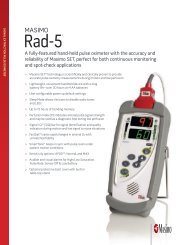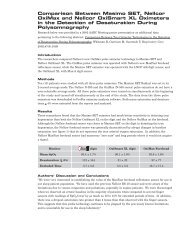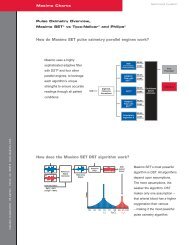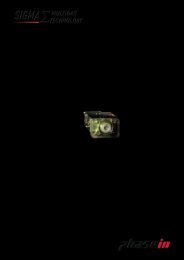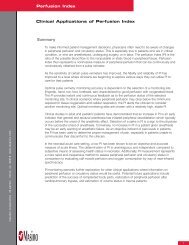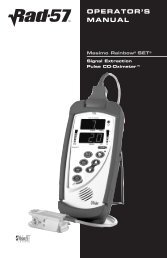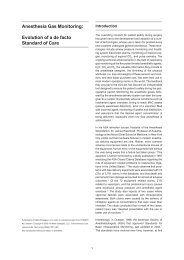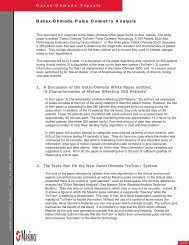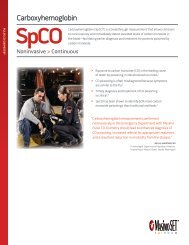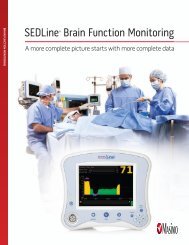Pulse Oximetry in Children With Congenital Heart Disease ... - Masimo
Pulse Oximetry in Children With Congenital Heart Disease ... - Masimo
Pulse Oximetry in Children With Congenital Heart Disease ... - Masimo
Create successful ePaper yourself
Turn your PDF publications into a flip-book with our unique Google optimized e-Paper software.
ORIGINAL RESEARCH<strong>Pulse</strong> <strong>Oximetry</strong> <strong>in</strong> <strong>Children</strong> <strong>With</strong><strong>Congenital</strong> <strong>Heart</strong> <strong>Disease</strong>: Effects ofCardiopulmonary Bypass and CyanosisAdalberto Torres Jr, MD, FAAP*Kelly M. Skender, MSN, PNP†Julie D. Wohrley, MD*Jean C. Aldag, PhD*Gary W. Raff, MD*G. Kris Bysani, MD*Dale M. Geiss, MD*The objective of this prospective, observational study withconsecutive sampl<strong>in</strong>g was to assess the reliability, bias,and precision of Nellcor N-395 (N) and <strong>Masimo</strong> SETRadical (M) pulse oximeters <strong>in</strong> children with cyanotic congenitalheart disease and children with congenital heartdisease recover<strong>in</strong>g from cardiopulmonary bypass–assistedsurgery admitted to a cardiovascular operat<strong>in</strong>g suite andpediatric <strong>in</strong>tensive care unit at a tertiary care communityhospital. Forty-six children with congenital heart diseasewere studied <strong>in</strong> 1 of 2 groups: (1) those recover<strong>in</strong>g fromcardiopulmonary bypass with a serum lactic acid > 2mmol/L, and (2) those with co-oximetry measured saturations(SaO 2) < 90% and no evidence of shock.Measurements of SaO 2of whole blood were compared tosimultaneous pulse oximetry saturations (SpO 2). Datawere analyzed to detect significant differences <strong>in</strong> SpO 2readout failures between oximeters and average SpO 2–SaO 2± 1 SD for each oximeter. A total of 122 SaO 2measurementswere recorded; the median SaO 2was 83% (57 –100%). SpO 2failures after cardiopulmonary bypass were41% (25/61) for N versus 10% (6/61) for M (P < .001).There was a significant difference <strong>in</strong> bias (ie, average SpO 2– SaO 2) and precision (± 1 SD) between oximeters (N, 1.1 ±3.3 vs M, –0.2 ± 4.1; P < .001) <strong>in</strong> the postcardiopulmonarybypass group but no significant difference <strong>in</strong> bias and precisionbetween oximeters <strong>in</strong> the cyanotic congenital heartdisease group (N, 2.9 ± 4.6 vs M, 2.8 ± 6.2; P = .848). TheNellcor N-395 pulse oximeter failed more often immediatelyafter cardiopulmonary bypass than did the <strong>Masimo</strong>From the *University of Ill<strong>in</strong>ois College of Medic<strong>in</strong>e at Peoriaand the †<strong>Children</strong>’s Hospital of Ill<strong>in</strong>ois at OSF St. Francis MedicalCenter, Peoria, Ill<strong>in</strong>ois.Received Jul 25, 2003, and <strong>in</strong> revised form Dec 29, 2003.Accepted for publication Dec 30, 2003.Address correspondence to Adalberto Torres Jr, MD, <strong>Children</strong>’sHospital of Ill<strong>in</strong>ois at OSF St. Francis Medical Center, 530 NEGlen Oak Ave, Peoria, IL, 61637; e-mail: altorres@uic.edu.Torres A Jr, Skender KM, Wohrley JD, Aldag JC, Raff GW, BysaniGK, Geiss DM. <strong>Pulse</strong> oximetry <strong>in</strong> children with congenital heartdisease: effects of cardiopulmonary bypass and cyanosis. JIntensive Care Med. 2004;19:229-234.DOI: 10.1177/0885066604263819SET Radical pulse oximeter. SpO2 measured with bothoximeters overestimated SaO2 <strong>in</strong> the presence of persistenthypoxemia.Key words: monitor<strong>in</strong>g, pediatrics, cardiac surgery, oxygensaturation, pulse oximetry, arterial blood gases<strong>Pulse</strong> oximetry is considered by many cl<strong>in</strong>icians asthe fifth vital sign and is widely used <strong>in</strong> many cl<strong>in</strong>icalsett<strong>in</strong>gs [1]. Intensivists rely heavily on this non<strong>in</strong>vasive<strong>in</strong>strument to cont<strong>in</strong>uously assess the adequacyof oxygenation and to track the need andresponse to therapy. However, it has been welldocumented that pulse oximetry is less reliable andless accurate under certa<strong>in</strong> conditions, such as poorperipheral perfusion and <strong>in</strong> children with hypoxemia[2-11]. Us<strong>in</strong>g various hypoperfusion models(eg, tourniquet, decreased ambient temperature),multiple <strong>in</strong>vestigators have demonstrated <strong>in</strong> adultvolunteers that pulse oximeters <strong>in</strong>creas<strong>in</strong>gly failand become less accurate, that is, > 2% difference <strong>in</strong>pulse oximeter saturation (SpO 2) and co-oximetermeasured saturation (SaO 2) [2,7,8]. Others havedemonstrated that pulse oximeters become lessaccurate <strong>in</strong> patients with hypoxemia, <strong>in</strong>clud<strong>in</strong>gboth children [4,5,9] and adults [6,10]. Cl<strong>in</strong>icianscar<strong>in</strong>g for patients with severe shock or hypoxemia(eg, children with cyanotic heart disease) are oftenrequired to obta<strong>in</strong> arterial blood gases to accuratelyassess the patient’s oxygenation or make a lessthan adequately <strong>in</strong>formed medical decision.Manufacturers of 2 newer generation pulseoximeters, the <strong>Masimo</strong> SET Radical and the NellcorN-395, claim an accuracy of ± 3% dur<strong>in</strong>g periods ofpoor peripheral perfusion and with arterial oxygensaturations as low as 70% [12,13]. These 2 oximetershave not been validated <strong>in</strong> children with poorCopyright © 2004 Sage Publications 229
Torres et alperfusion or hypoxemia. We hypothesized thatSpO 2measured with the Nellcor N-395 and the<strong>Masimo</strong> SET Radical pulse oximeters were neitheraccurate nor precise when compared with SaO 2ofthe whole blood of children immediately recover<strong>in</strong>gfrom cardiopulmonary bypass, a transient periodof poor peripheral perfusion, or <strong>in</strong> children withpersistent hypoxemia (ie, an SaO 2< 90%).Materials and MethodsA prospective observational study with consecutivesampl<strong>in</strong>g was proposed to the community <strong>in</strong>stitutionalreview board and approved. The study wasdeemed exempt from requir<strong>in</strong>g <strong>in</strong>formed consentby the community <strong>in</strong>stitutional review board.Two groups of children with congenital heart diseasewere studied: (1) children undergo<strong>in</strong>g cardiopulmonarybypass–assisted cardiac surgery and(2) children with persistent hypoxemia. Twentyfivechildren with congenital heart disease undergo<strong>in</strong>gsurgical repair (n = 13) or palliation (n = 12)us<strong>in</strong>g cardiopulmonary bypass, arterial catheter <strong>in</strong>place, and a serum lactic acid ≥ 2 mmol/L (ie, evidenceof <strong>in</strong>sufficient tissue perfusion) were recruitedbetween February 27, 2001, and August 6, 2001.Patients were excluded if pulse oximeter read<strong>in</strong>gswith<strong>in</strong> 2% of each other prior to the start of cardiopulmonarybypass were unobta<strong>in</strong>able and if theserum lactic acid was < 2 mmol/L after cardiopulmonarybypass.Twenty-one children with cyanotic congenitalheart disease, an arterial catheter <strong>in</strong> place, and ameasured SaO 2consistently less than 90% on serialblood gases were recruited between August 7, 2001,and December 18, 2002. Four children wereenrolled on 2 separate occasions follow<strong>in</strong>g dist<strong>in</strong>ctoperations. To avoid recruit<strong>in</strong>g patients <strong>in</strong> a state ofpoor perfusion similar to the postcardiopulmonarybypass period, patients <strong>in</strong> this group were excludedif they displayed any cl<strong>in</strong>ical features of shock(eg, tachycardia, cool peripheral extremities, oliguria,serum lactic acid ≥ 2 mmol/L, etc).The pulse oximeters tested were the <strong>Masimo</strong> SETRadical (version 3, <strong>Masimo</strong> Corporation, Irv<strong>in</strong>e,Calif) and the Nellcor N-395 (Nellcor PuritanBennett, Inc, Pleasanton, Calif). The whole-bloodco-oximeter used to measure SaO 2<strong>in</strong> the postcardiopulmonarybypass group was the ILSynthesis 1725 (Instrumentation Laboratories,Lex<strong>in</strong>gton, Mass). Because of an <strong>in</strong>stitutionalchange <strong>in</strong> laboratory equipment, the whole-bloodco-oximeter used to measure SaO 2<strong>in</strong> the cyanoticcongenital heart disease group was the IL 682(Instrumenta-tion Laboratories, Lex<strong>in</strong>gton, Mass).A pulse oximeter probe attached to each oximeterwas attached to the same distal extremity: oneon a digit and the other on the palm or sole. Probeswere not attached to extremities with arterialcatheters <strong>in</strong> place to avoid potential <strong>in</strong>terferencefrom dim<strong>in</strong>ished arterial blood flow. Palliativeshunts were positioned centrally, that is, aorta topulmonary artery confluence, when placed <strong>in</strong> certa<strong>in</strong>patients (eg, hypoplastic left heart syndrome,unbalanced atrioventricular canal), mak<strong>in</strong>g it feasibleto obta<strong>in</strong> an SpO 2measurement for comparisonfrom an extremity different from the extremity withthe arterial catheter. The probes were opticallyshielded. SpO 2displayed on each pulse oximeter atthe time rout<strong>in</strong>e arterial blood SaO 2measurementswere recorded. Cardiopulmonary monitor heartrate, pulse oximeter heart rate, and failure of pulseoximeter to display SpO 2at the time of the bloodgases measurement were also recorded for analysis.Core temperature, cardiopulmonary bypasstime, and aortic cross-clamp time were recordedfor analysis <strong>in</strong> the cardiopulmonary bypass group.None of the subjects <strong>in</strong> the cyanotic congenitalheart disease group were hypothermic (ie, coretemperature < 36°C) at the time of study measurements,and therefore, core temperature was notmeasured.Bias and precision, measures of agreementdescribed by Bland and Altman [14], were used tocompare SpO 2measurements by both oximeterswith the co-oximetry SaO 2measurements. Bias isdef<strong>in</strong>ed as the average of the differences betweenthe method be<strong>in</strong>g tested and the gold standard(SpO 2– SaO 2), and the precision is the standarddeviation of that difference. The expected range ofthat difference between the 2 measurements, thatis, the limits of agreement, are then calculated asthe bias ± 1.96 × SD. These data po<strong>in</strong>ts were graphicallydisplayed as bias plots. The vertical axis representedthe SpO 2– SaO 2difference, and the horizontalaxis represented the average saturation[(SpO 2+ SaO 2)/ 2]. χ 2 test was used to detect a significantdifference <strong>in</strong> data readout failures betweenoximeters at the time of the SaO 2measurements <strong>in</strong>the postcardiopulmonary bypass group. AWilcoxon signed ranks test was used to detect differences<strong>in</strong> matched data (ie, pulse oximeter heartrate and cardiac monitor heart rate), and the Mann-Whitney U test was used to detect differences <strong>in</strong>unmatched data. Spearman rank correlation wasused to detect significant relationships between theabsolute SpO 2– SaO 2differences and patient characteristics(eg, hematocrit, core temperature, aortic230 Journal of Intensive Care Medic<strong>in</strong>e 19(4); 2004
Pediatric <strong>Heart</strong> <strong>Pulse</strong> <strong>Oximetry</strong>cross-clamp time). Mean differences ± 1 standarddeviation were reported. A P value < .05 was consideredsignificant.ResultsTable 1 conta<strong>in</strong>s the characteristics of the 46patients enrolled. There were a total of 122 SaO 2measurements obta<strong>in</strong>ed, 61 measurementsobta<strong>in</strong>ed <strong>in</strong> each group. The median (range) SaO 2measurement was 83% (57%-100%). Seventy-sevenof the 122 (63%) SaO 2measurements obta<strong>in</strong>edwere less than 90%. The median serum lactic acidconcentration was 1.8 mmol/L (0.4-12.7). Themedian hematocrit was 40% (19%-54%).Postcardiopulmonary Bypass GroupThe Nellcor N-395 pulse oximeter failed to measurethe SpO 2dur<strong>in</strong>g 41% (25/61) of the SaO 2measurementscompared to 10% (6/61) for the <strong>Masimo</strong> SETRadical pulse oximeter (P < .001). There was a significantdifference <strong>in</strong> bias ± precision but no significantdifference <strong>in</strong> heart rate between oximeters(see Table 2).There was a significantly negative relationshipbetween absolute SpO 2– SaO 2difference of<strong>Masimo</strong> SET Radical and aortic cross-clamp time (r= –0.29, P = .03) and core temperature (r = –0.42,P = .001). Both pulse oximeters had significantlypositive relationships between absolute SpO 2–SaO 2difference and hematocrit (Nellcor N-395: r =0.46, P < .01; <strong>Masimo</strong> SET Radical: r = 0.35, P
Torres et alTable 2. Differences <strong>in</strong> Oximeter MeasurementsVariable (Mean Difference ± 1 SD) Nellcor <strong>Masimo</strong> P nPostcardiopulmonary bypass SpO 2– SaO 21.1 ± 3.3 –0.2 ± 4.1 < .001 33Oximeter heart rate – monitor heart rate 0.7 ± 6.9 –0.6 ± 1.9 .819 33Cyanotic congenital heart disease SpO 2– SaO 22.9 ± 4.6 2.8 ± 6.2 .848 61Oximeter heart rate – monitor heart rate –0.1 ± 2.0 –0.05 ± 1.8 .973 61202015151010SpO2 - SaO250-5-10-15*SpO2 - SaO250-5-10*-20-15-2560 65 70 75 80 85 90 95 100(SpO 2+SaO 2)/2 (%)Fig 1. Bias plot of <strong>Masimo</strong> SET Radical pulse oximeter (n= 55). Bold l<strong>in</strong>es represent average SpO 2– SaO 2difference(bias, d), and the dotted l<strong>in</strong>es represent precision(d ± 2 SD). *SpO 2– SaO 2= 0 at 100%, n = 14.-2060 65 70 75 80 85 90 95 100(SpO 2 + SaO 2)/2 (%)Fig 2. Bias plot of Nellcor N-395 pulse oximeter (n = 36).Bold l<strong>in</strong>es represent average SpO 2– SaO 2difference(bias, d), and the dotted l<strong>in</strong>es represent precision (d ± 2SD). *SpO 2– SaO 2= 0 at 100%, n = 8.conditions. <strong>Masimo</strong>’s Signal Extraction Technology(SET) applies multiple algorithms to filter the pulsesignal and to extract the arterial from the venoussignal and report the true SpO 2and pulse rate dur<strong>in</strong>gmotion and low perfusion conditions [13]. Wecompared these 2 technologically advanced pulseoximeters to the gold standard, measured SaO 2, toevaluate their performance under 2 conditionsprone to <strong>in</strong>accuracies: low perfusion and hypoxemia.<strong>Children</strong> who have undergone cardiopulmonarybypass with subsequent lactic acidosis areconsidered comparable to children with a pathologicallycaused low perfusion condition [15]. Themajor difference between the Nellcor N-395 andthe <strong>Masimo</strong> SET was the proportion of readout failures<strong>in</strong> the postbypass group (41% vs 10%, respectively).A study compar<strong>in</strong>g percentage of nonfunctionalmonitor<strong>in</strong>g time after coronary artery bypasssurgery <strong>in</strong> 86 adults revealed that the <strong>Masimo</strong> SEToutperformed the Ohmeda 3740 pulse oximeter(1.2% ± 3.3% for <strong>Masimo</strong> SET vs 8.7% ± 16.4% forOhmeda 3740; P < .001) [16]. Iyer and colleagues[17] demonstrated that the drop <strong>in</strong> peripheral sk<strong>in</strong>temperature that occurs dur<strong>in</strong>g cardiac surgery withcardiopulmonary bypass caused unreliable pulseoximeter read<strong>in</strong>gs. However, 2 other studies ofNellcor pulse oximeters dur<strong>in</strong>g cardiac surgerydemonstrated no relationship of peripheral sk<strong>in</strong>temperature to accuracy or failure [18,19]. We diddemonstrate a negative correlation between thecore temperature and the absolute SpO 2– SaO 2differencefor the <strong>Masimo</strong> SET Radical but not for theNellcor N-395. The high failure rate for the NellcorN-395 dur<strong>in</strong>g low perfusion conditions would likelyresult <strong>in</strong> a greater number of arterial blood gasesbe<strong>in</strong>g performed to ensure adequate SaO 2.Another significant f<strong>in</strong>d<strong>in</strong>g of our study was the<strong>in</strong>crease <strong>in</strong> bias and precision, that is, loss of accuracyand <strong>in</strong>crease <strong>in</strong> scatter, for both oximeterswhen SaO 2was < 90%. Both manufacturers assertthat their pulse oximeter is “accurate” even at a lowSaO 2of 70% [12,13]. Bell and colleagues [9] reporteda significant <strong>in</strong>crease <strong>in</strong> precision for 3 oximeters(Ohmeda 3700, Novametrix 520A, and theNellcor N-200) when the SaO 2was < 90% <strong>in</strong> childrenundergo<strong>in</strong>g major operations <strong>in</strong>clud<strong>in</strong>g cardiacsurgery. Jubran and Tob<strong>in</strong> [10] found a significant<strong>in</strong>crease <strong>in</strong> bias and precision for a Nellcorbrand pulse oximeter and an Ohmeda 3700 pulseoximeter when the SaO 2was ≤ 90% compared toan SaO 2> 90% (5.1% ± 2.7% vs 1.7% ± 1.2%; P
Pediatric <strong>Heart</strong> <strong>Pulse</strong> <strong>Oximetry</strong>precision with an SaO 2< 80% [5], and the otherreported no difference with an SaO 2of < 80% [20].The <strong>in</strong>crease <strong>in</strong> scatter on the bias plots appears tooccur at (SpO 2+ SaO 2)/2 < 90% for the <strong>Masimo</strong>Radical SET compared to (SpO 2+ SaO 2)/2 < 80% forthe Nellcor N-395. Algorithms used by the manufacturersprobably do not conta<strong>in</strong> adequate numbersof patients with hypoxemia, which mightexpla<strong>in</strong> these f<strong>in</strong>d<strong>in</strong>gs. The apparent <strong>in</strong>crease <strong>in</strong>bias and precision when SaO 2was < 90% <strong>in</strong> thepostcardiopulmonary group versus the persistenthypoxemia group may have been secondary to thecomb<strong>in</strong>ation of low perfusion and hypoxemia <strong>in</strong>the postcardiopulmonary group or the different cooximetermethodology used <strong>in</strong> each group (lightscatter [IL Synthesis 1725] vs spectrophotometry [IL682]). Published data compar<strong>in</strong>g the 2 technologieswere lack<strong>in</strong>g. Nevertheless, the results <strong>in</strong> bothgroups confirmed dim<strong>in</strong>ished pulse oximeter performancewhen SaO 2< 90%.It has been well documented that different pulseoximeters do not perform similarly when testedunder other adverse conditions [2-11]. For example,Van de Louw and colleagues [21] reported a statisticallysignificant (but not cl<strong>in</strong>ically significant) difference<strong>in</strong> bias for 3 pulse oximeters (Nellcor N-200, Ohmeda 3700, and the Hewlett PackardViridia 24C) when vasoactive agents were be<strong>in</strong>gadm<strong>in</strong>istered to children admitted to a pediatric<strong>in</strong>tensive care unit. Other studies of older generationsof pulse oximeters still widely used havereported variable performances when tested underdifferent, low perfusion conditions [15,22]. Macnaband colleagues [15] reported a bias < 2% for theBiox 3700 <strong>in</strong> 58 children recover<strong>in</strong>g from deephypothermia for cardiac surgery regardless of coretemperature, while Ibáñez and colleagues [22]reported an absolute bias of > 4% for the Biox 3700pulse oximeter <strong>in</strong> 9 of 24 (37%) adult patientsreceiv<strong>in</strong>g vasoactive agents.The absolute bias and precision for both oximeterscorrelated best with the patients’ hematocrit <strong>in</strong>the cardiopulmonary bypass group but not <strong>in</strong> thepersistent hypoxemia group. One study exam<strong>in</strong><strong>in</strong>gthe accuracy of the Nellcor N-100 pulse oximeter <strong>in</strong>children with cyanotic congenital heart disease didnot demonstrate a correlation between high hematocritconcentrations and the oximeter’s bias andprecision [5]. Hematocrit of the whole blood mayhave a greater impact on the rheology of the redblood cells under low perfusion conditions andtherefore alter the reflective characteristics of capillaryblood. The lack of a correlation between pulsepressure and the absolute bias and precision aresimilar to the f<strong>in</strong>d<strong>in</strong>gs of Villanueva and colleagues[3], who found only a weak correlation betweenpulse pressure and the bias of the Nellcor N-200pulse oximeter.One limitation of our study was the lack ofperipheral sk<strong>in</strong> temperature monitor<strong>in</strong>g. Studieshave reported conflict<strong>in</strong>g data regard<strong>in</strong>g the relationshipbetween peripheral sk<strong>in</strong> temperature andpulse oximeter performance as mentioned previously.Barker and colleagues demonstrated thatsensor malposition<strong>in</strong>g dur<strong>in</strong>g pulse oximetry test<strong>in</strong>gunder conditions of hypoxemia significantlyaltered accuracy [23]. Although sensor position<strong>in</strong>gcould not be checked dur<strong>in</strong>g the study <strong>in</strong> the cardiopulmonarybypass group, the patients were allneuromuscularly blocked dur<strong>in</strong>g the test<strong>in</strong>g, mak<strong>in</strong>git unlikely that patient motion caused sensormalposition<strong>in</strong>g. Probes were exam<strong>in</strong>ed for sensorposition<strong>in</strong>g after the measurements were made,and none of the probes appeared displaced. Andf<strong>in</strong>ally, probe position may have <strong>in</strong>fluenced theresults of our study. No data were available regard<strong>in</strong>gdifferences <strong>in</strong> accuracy based on probe position(eg, toe vs sole of the foot). S<strong>in</strong>ce no attemptswere made to randomly place the different probes<strong>in</strong> the different positions, it is possible that probeposition may have <strong>in</strong>fluenced our results.ConclusionsThe <strong>Masimo</strong> Radical SET and Nellcor N-395 pulseoximeters have an acceptable accuracy but unacceptableprecision <strong>in</strong> children with congenital heartdisease. The Nellcor N-395 pulse oximeter failedsignificantly more often than the <strong>Masimo</strong> SETRadical pulse oximeter did <strong>in</strong> children with lacticacidosis recover<strong>in</strong>g from cardiopulmonary bypass.Performance of both oximeters worsened whenSaO 2was < 90% compared to SaO 2of ≥ 90%.Cl<strong>in</strong>icians should refra<strong>in</strong> from alter<strong>in</strong>g managementof the child with cyanotic congenital heart diseasebased solely on pulse oximetry read<strong>in</strong>gs with thepulse oximeters studied.AcknowledgmentsThis study was supported <strong>in</strong> part by theDepartment of Pediatrics, University of Ill<strong>in</strong>oisCollege of Medic<strong>in</strong>e at Peoria. We are grateful tothe cardiovascular surgery and pediatric <strong>in</strong>tensivecare unit staff for their patience and are especiallygrateful to the perfusionists for their unselfish assistance.We are also grateful to the <strong>Masimo</strong>Journal of Intensive Care Medic<strong>in</strong>e 19(4); 2004 233
Torres et alCorporation for the unreimbursed supply of<strong>Masimo</strong> SET pulse oximeter probes. This study waspresented <strong>in</strong> part at the Society of Critical CareMedic<strong>in</strong>e’s 32nd Society of Critical Care Medic<strong>in</strong>eCongress, San Diego, California, January 28, 2002,and at the 31st Society of Critical Care Medic<strong>in</strong>eCongress, San Antonio, Texas, January 30, 2003.References1. Tremper KK. <strong>Pulse</strong> oximetry’s f<strong>in</strong>al frontier. Crit Care Med.2000;28:1684-1685.2. Trivedi NS, Ghouri AF, Shah NK, Lai E, Barker SJ. Effects ofmotion, ambient light, and hypoperfusion on pulse oximeterfunction. J Cl<strong>in</strong> Anesth. 1997;9:179-183.3. Villanueva R, Bell C, Ka<strong>in</strong> ZN, Col<strong>in</strong>go KA. Effect ofperipheral perfusion on accuracy of pulse oximetry <strong>in</strong> children.J Cl<strong>in</strong> Anesth. 1999;11:317-322.4. Carter BG, Carl<strong>in</strong> JB, Tibballs J, Mead H, Hochmann M.Accuracy of two pulse oximeters at low arterial hemoglob<strong>in</strong>oxygensaturation. Crit Care Med. 1998;26:1128-1133.5. Schmitt HJ, Schuetz WH, Proeschel, Jakl<strong>in</strong> C. Accuracy ofpulse oximetry <strong>in</strong> children with cyanotic congenital heartdisease. J Cardiothorac Vasc Anesth. 1993;7:61-65.6. Thrush D, Hodges MR. Accuracy of pulse oximetry dur<strong>in</strong>ghypoxemia. South Med J. 1994;87:518-521.7. Sever<strong>in</strong>ghaus JW, Spellman MJ. <strong>Pulse</strong> oximeter failurethresholds <strong>in</strong> hypotension and vasoconstriction.Anesthesiology. 1990;73:532-537.8. Morris RW, Nairn M, Torda TA. A comparison of fifteenpulse oximeters. Part I: a cl<strong>in</strong>ical comparison; part II: a testof performance under conditions of poor perfusion.Anaesth Intensive Care. 1989;17:62-82.9. Bell C, Luther MA, Nicholson JJ, Fox CJ, Hirsch JL. Effect ofprobe design on accuracy and reliability of pulse oximetry<strong>in</strong> pediatric patients. J Cl<strong>in</strong> Anesth. 1999;11:323-327.10. Jubran A, Tob<strong>in</strong> MJ. Reliability of pulse oximetry <strong>in</strong> titrat<strong>in</strong>gsupplemental oxygen therapy <strong>in</strong> ventilator-dependentpatients. Chest. 1990;97:1420-1425.11. Bohnhorst B, Peter CS, Poets CF. <strong>Pulse</strong> oximeters’ reliability<strong>in</strong> detect<strong>in</strong>g hypoxemia and bradycardia: comparisonbetween a conventional and two new generation oximeters.Crit Care Med. 2000;28:1565-1568.12. Nellcor Puritan Bennet, Inc. Nellcor N-395 pulse oximeterproduct description. Available at: http://www.nellcor.com/products/<strong>in</strong>dex.asp. Accessed January 15, 2003.13. <strong>Masimo</strong> Corporation. Radical signal extraction pulseoximeter sales sheet. Available at: http://www.masimo.com/pusleox/radical.htm. Accessed January 15, 2003.14. Bland JM, Altman DG. Statistical methods for assess<strong>in</strong>gagreement between two methods of cl<strong>in</strong>ical measurement.Lancet. 1986;1(8476):307-310.15. Macnab AJ, Baker-Brown G, Anderson EE. <strong>Oximetry</strong> <strong>in</strong>children recover<strong>in</strong>g from deep hypothermia for cardiacsurgery. Crit Care Med. 1990;18:1066-1069.16. Durb<strong>in</strong> CJ, Rostow SK. More reliable oximetry reduces thefrequency of arterial blood gas analyses and hastens oxygenwean<strong>in</strong>g after cardiac surgery: a prospective randomizedtrial of the cl<strong>in</strong>ical impact of a new technology. CritCare Med. 2002;30:1735-1740.17. Iyer P, McDougall P, Loughnan P, et al. Accuracy of pulseoximetry <strong>in</strong> hypothermic neonates and <strong>in</strong>fants undergo<strong>in</strong>gcardiac surgery. Crit Care Med. 1996;24:507-511.18. Pälve H, Vuori A. M<strong>in</strong>imum pulse pressure and peripheraltemperature needed for pulse oximetry dur<strong>in</strong>g cardiac surgerywith cardiopulmonary bypass. J Cardiothorac VascAnesth. 1991;5:327-330.19. Carter BG, Wiwczaruk D, Hochmann M, Henn<strong>in</strong>g R.Performance of transcutaneous PCO 2and pulse oximetrymonitors <strong>in</strong> newborns and <strong>in</strong>fants after cardiac surgery.Anaesth Intensive Care. 2001;29:260-265.20. Boxer RA, Gottesfeld I, S<strong>in</strong>gh S, et al. Non<strong>in</strong>vasive pulseoximetry <strong>in</strong> children with cyanotic congenital heart disease.Crit Care Med. 1987;15:1062-1064.21. Van de Louw A, Cracco C, Cerf C, et al. Accuracy of pulseoximetry <strong>in</strong> the <strong>in</strong>tensive care unit. Intensive Care Med.2001;27:1606-1613.22. Ibañez J, Velasco J, Raurich JM. The accuracy of the Biox3700 pulse oximeter <strong>in</strong> patients receiv<strong>in</strong>g vasoactive therapy.Intensive Care Med. 1991;17:484-486.23. Barker SJ, Hyatt J, Shah NK, Kao J. The effect of sensormalposition<strong>in</strong>g on pulse oximeter accuracy dur<strong>in</strong>g hypoxemia.Anesthesiology. 1993;79:248-254.234 Journal of Intensive Care Medic<strong>in</strong>e 19(4); 2004




